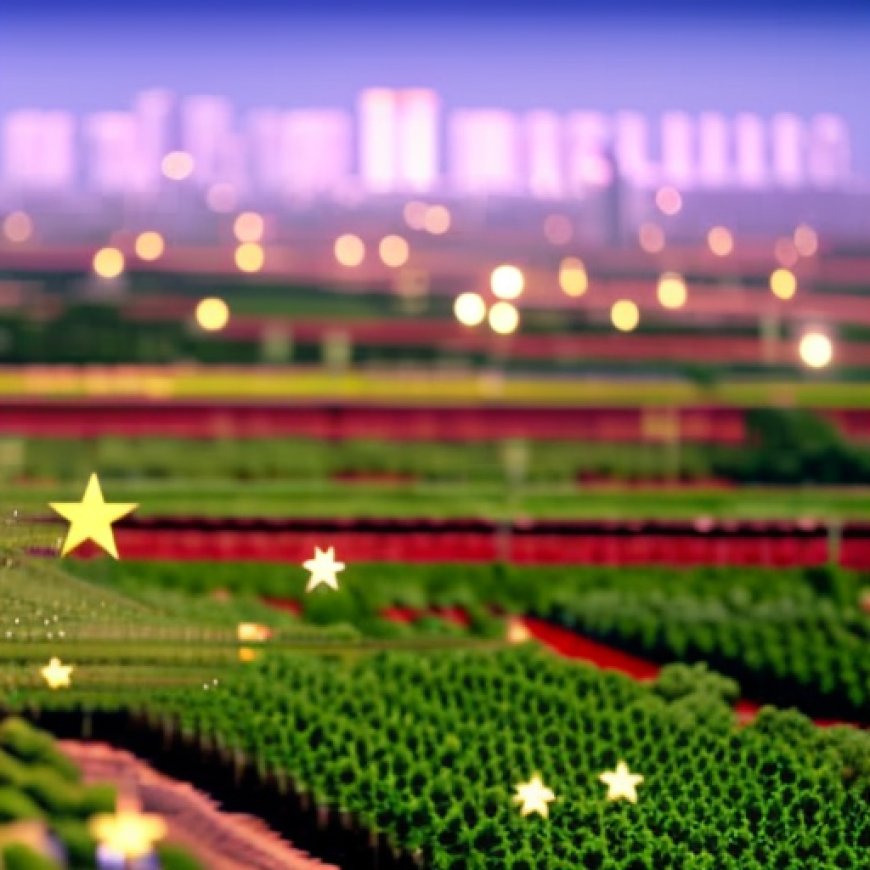China’s Five-Year Advancements in Green Agricultural Development
China's Five-Year Advancements in Green Agricultural Development Mirage News


China’s Five-Year Advancements in Green Agriculture Development

Introduction
Reconciling the tasks of producing adequate amounts of nutritious food for the increasing global population while preserving the environment and natural ecosystems simultaneously is an enormous challenge. The concept of agriculture green development (AGD) was detailed in 2017 and the necessary governmental policies were developed to address the aforementioned challenge in China and to help achieve the related global sustainable development goals.
The Three Main Systems of AGD
The AGD special plan distinguishes three main systems, including the natural system, the food system, and the human and social system. The food system has four subsystems:
- Green crop production
- Green integrated crop-animal production
- Green food and industry
- Green ecological environment and ecosystem services
Progress of AGD
Prof. Fusuo Zhang and Jianbo Shen from China Agricultural University and their team present the progress of AGD that has been made over the past 5 years and make recommendations for more research and development, in order to better deliver agricultural green and sustainable development on national and international scales. The AGD research program was established as a collaboration between several universities, governments, and the private sector in China, under the guidance of China Agricultural University in Beijing. International universities are also involved, such as the ongoing joint PhD research program between Wageningen University and China Agricultural University.
The Four Research Themes of AGD
The four research themes of the AGD research program each receive roughly similar financial research support:
- Green Crop Production: Developing innovative crop production methods and technologies for producing adequate amounts of healthy and nutritious plant-based food with reduced agrochemical inputs and lower environmental impacts.
- Green Integrated Crop-Animal Production: Exploring ways to better integrate crop and animal production systems for improved nutrient cycling, enhanced feed production and feed use efficiency, and increased animal productivity.
- Green Food and Industries: Adding value to food products for both consumers and producers, lowering the environmental footprint of food products, and boosting and transforming food industries.
- Green Ecological Environment and Ecosystem Services: Quantifying and minimizing the overall impact of food production and consumption on the environment, developing landscapes and measures to improve biodiversity and ecosystem services.
Key Findings and Recommendations
The group has acquired a series of new understandings in all four themes, which have important implications for the implementation of AGD in practice. AGD requires a multistakeholder approach, fueled by innovative and interdisciplinary research. Synergistic realization of multiple goals is a key requirement for AGD, and interactions and coupling mechanisms within systems require more attention. Joint actions have to be taken by governments, farmers, supply industries, consumers, educators, extension services, and researchers to support AGD. This requires strong coordination and public awareness campaigns. International and regional cooperation, knowledge sharing, technology transfer, talent training, and consultation are also essential for AGD.
Conclusion
China is ready to work with other countries to deepen cooperation, help more countries and more people share the benefits of development, and make new and greater contributions to building a community with a shared future for humankind without poverty and with common development goals.
This study has been published on the Journal of Frontiers of Agricultural Science and Engineering in Volume 11, Issue 1, 2024.
SDGs, Targets, and Indicators
-
SDG 2: Zero Hunger
- Target 2.3: By 2030, double the agricultural productivity and incomes of small-scale food producers, in particular women, indigenous peoples, family farmers, pastoralists, and fishers, including through secure and equal access to land, other productive resources and inputs, knowledge, financial services, markets, and opportunities for value addition and non-farm employment.
- Indicator 2.3.1: Volume of production per labor unit by classes of farming/pastoral/forestry enterprise size.
-
SDG 12: Responsible Consumption and Production
- Target 12.4: By 2020, achieve the environmentally sound management of chemicals and all wastes throughout their life cycle, in accordance with agreed international frameworks, and significantly reduce their release to air, water and soil in order to minimize their adverse impacts on human health and the environment.
- Indicator 12.4.1: Number of parties to international multilateral environmental agreements on hazardous waste, and other chemicals that meet their commitments and obligations in transmitting information as required by each relevant agreement.
-
SDG 13: Climate Action
- Target 13.1: Strengthen resilience and adaptive capacity to climate-related hazards and natural disasters in all countries.
- Indicator 13.1.1: Number of deaths, missing persons and directly affected persons attributed to disasters per 100,000 population.
-
SDG 15: Life on Land
- Target 15.1: By 2020, ensure the conservation, restoration and sustainable use of terrestrial and inland freshwater ecosystems and their services, in particular forests, wetlands, mountains and drylands, in line with obligations under international agreements.
- Indicator 15.1.1: Forest area as a proportion of total land area.
Table: SDGs, Targets, and Indicators
| SDGs | Targets | Indicators |
|---|---|---|
| SDG 2: Zero Hunger | Target 2.3: By 2030, double the agricultural productivity and incomes of small-scale food producers, in particular women, indigenous peoples, family farmers, pastoralists, and fishers, including through secure and equal access to land, other productive resources and inputs, knowledge, financial services, markets, and opportunities for value addition and non-farm employment. | Indicator 2.3.1: Volume of production per labor unit by classes of farming/pastoral/forestry enterprise size. |
| SDG 12: Responsible Consumption and Production | Target 12.4: By 2020, achieve the environmentally sound management of chemicals and all wastes throughout their life cycle, in accordance with agreed international frameworks, and significantly reduce their release to air, water and soil in order to minimize their adverse impacts on human health and the environment. | Indicator 12.4.1: Number of parties to international multilateral environmental agreements on hazardous waste, and other chemicals that meet their commitments and obligations in transmitting information as required by each relevant agreement. |
| SDG 13: Climate Action | Target 13.1: Strengthen resilience and adaptive capacity to climate-related hazards and natural disasters in all countries. | Indicator 13.1.1: Number of deaths, missing persons and directly affected persons attributed to disasters per 100,000 population. |
| SDG 15: Life on Land | Target 15.1: By 2020, ensure the conservation, restoration and sustainable use of terrestrial and inland freshwater ecosystems and their services, in particular forests, wetlands, mountains and drylands, in line with obligations under international agreements. | Indicator 15.1.1: Forest area as a proportion of total land area. |
Analysis
The article discusses the concept of agriculture green development (AGD) and its progress in China over the past five years. The issues highlighted in the article are related to sustainable agriculture, environmental preservation, and achieving global sustainable development goals.
1. Which SDGs are addressed or connected to the issues highlighted in the article?
The issues highlighted in the article are connected to the following SDGs:
- SDG 2: Zero Hunger
- SDG 12: Responsible Consumption and Production
- SDG 13: Climate Action
- SDG 15: Life on Land
2. What specific targets under those SDGs can be identified based on the article’s content?
Based on the article’s content, the specific targets under the identified SDGs are:
- Target 2.3: By 2030, double the agricultural productivity and incomes of small-scale food producers, in particular women, indigenous peoples, family farmers, pastoralists, and fishers, including through secure and equal access to land, other productive resources and inputs, knowledge, financial services, markets, and opportunities for value addition and non-farm employment.
- Target 12.4: By 2020, achieve the environmentally sound management of chemicals and all wastes throughout their life cycle, in accordance with agreed international frameworks, and significantly reduce their release to air, water and soil in order to minimize their adverse impacts on human health and the environment.
- Target 13.1: Strengthen resilience and adaptive capacity to climate-related hazards and natural disasters in all countries.
- Target 15.1: By 2020, ensure the conservation, restoration and sustainable use of terrestrial and inland freshwater ecosystems and their services, in particular forests, wetlands, mountains and drylands, in line with obligations under international agreements.
3. Are there any indicators mentioned or implied in the article that can be
Behold! This splendid article springs forth from the wellspring of knowledge, shaped by a wondrous proprietary AI technology that delved into a vast ocean of data, illuminating the path towards the Sustainable Development Goals. Remember that all rights are reserved by SDG Investors LLC, empowering us to champion progress together.
Source: miragenews.com

Join us, as fellow seekers of change, on a transformative journey at https://sdgtalks.ai/welcome, where you can become a member and actively contribute to shaping a brighter future.







